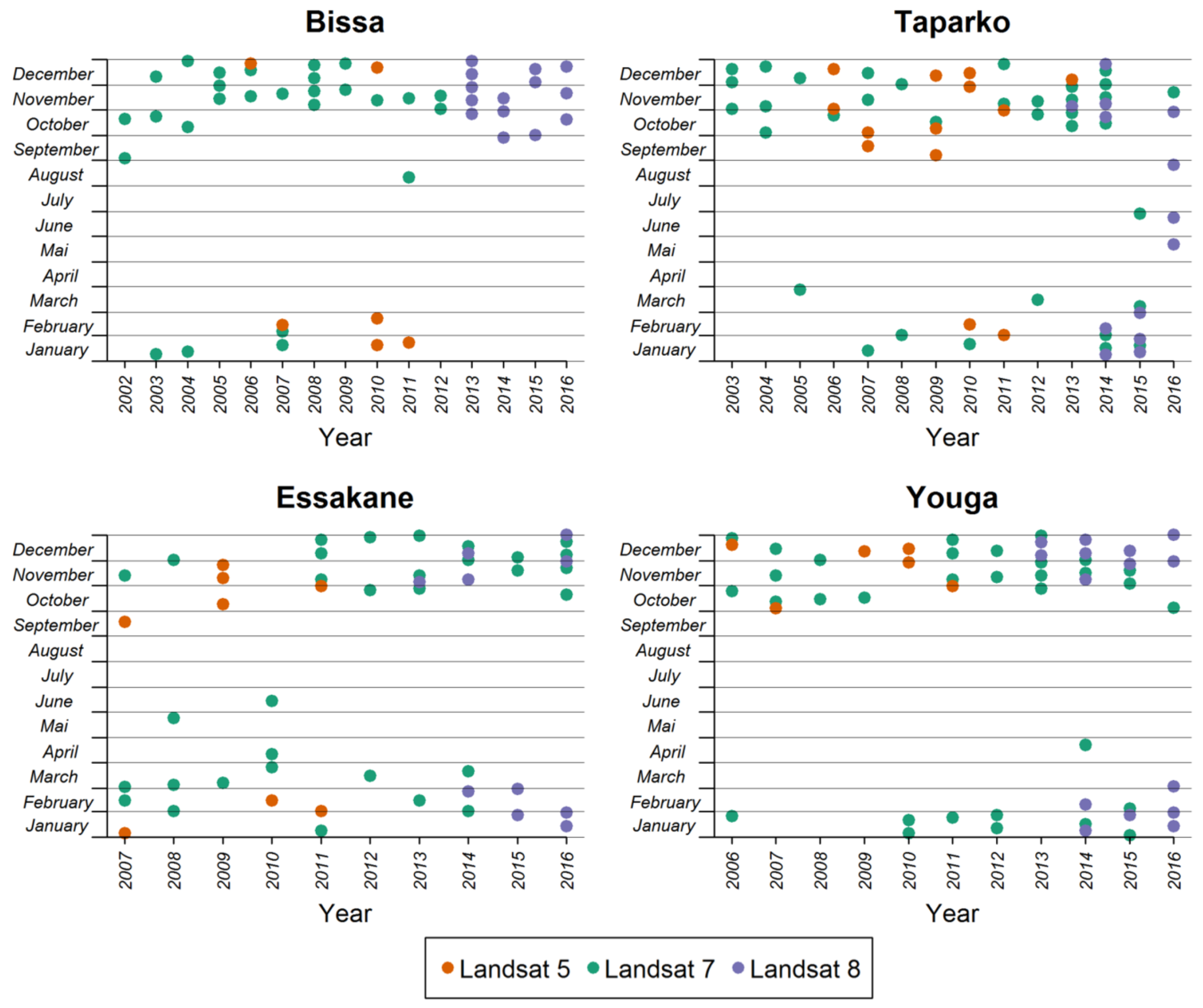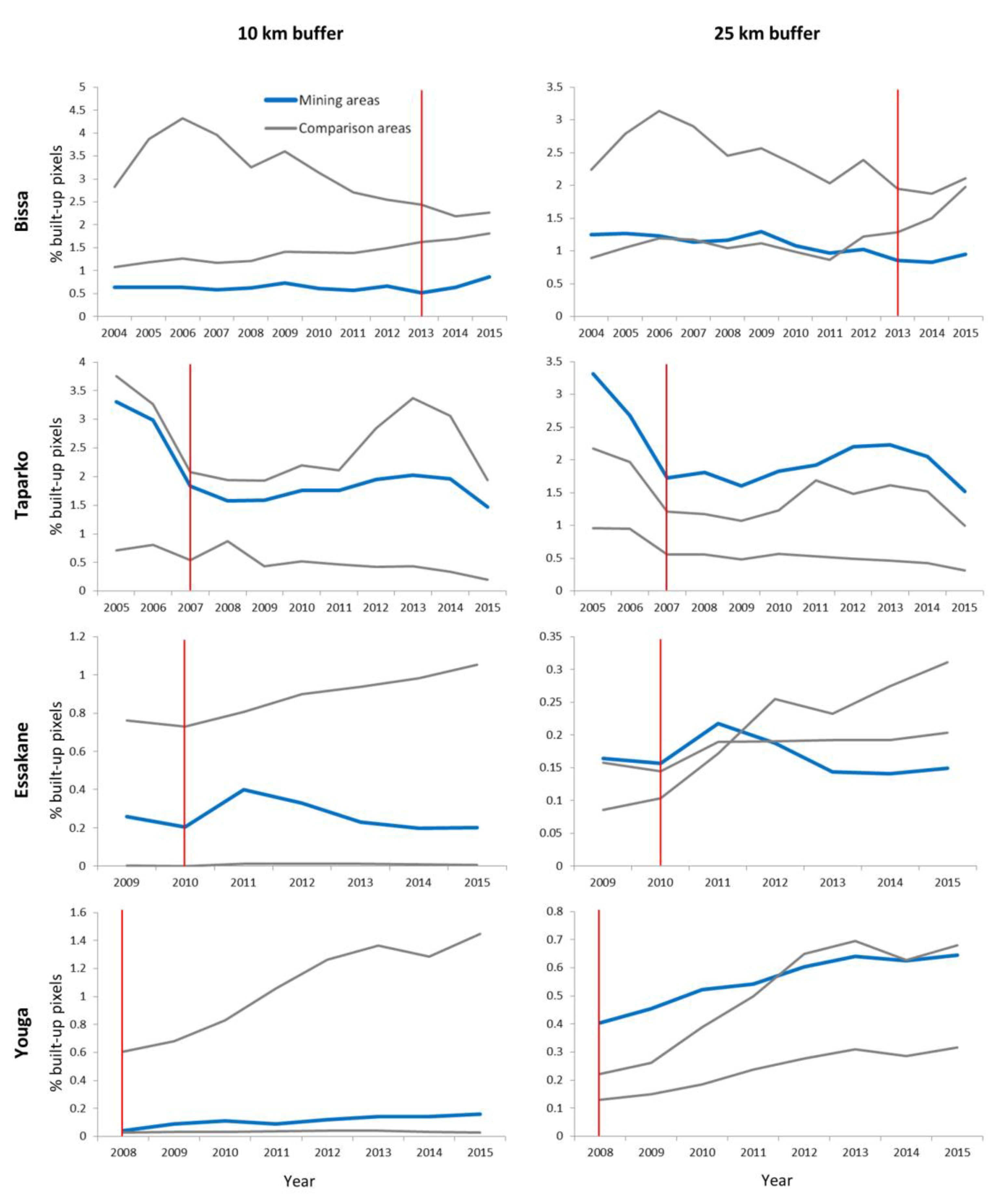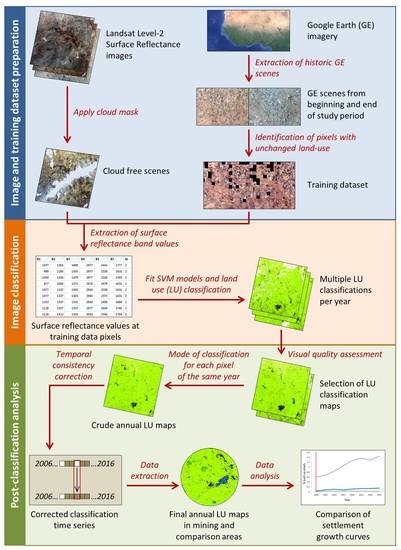Quantification of Annual Settlement Growth in Rural Mining Areas Using Machine Learning
Abstract
:1. Introduction
2. Materials and Methods
2.1. Study Area Selection
2.2. Data Sources
2.3. Land Use Classification
2.3.1. Image and Training Dataset Preparation
2.3.2. Image Classification
2.3.3. Post-Classification Processing
2.4. Accuracy Assessment
2.5. Data Analysis
3. Results
3.1. Availability of Landsat Satellite Imagery
3.2. Availability of Historic Google Earth Imagery
3.3. Settlement Growth in Mining and Non-Mining Areas
3.4. Accuracy Assessment
4. Discussion
5. Conclusions
Author Contributions
Funding
Acknowledgments
Conflicts of Interest
References
- Jackson, R.T. Migration to two mines in Laos. Sustain. Dev. 2018, 26, 471–480. [Google Scholar] [CrossRef]
- Nyame, F.K.; Andrew Grant, J.; Yakovleva, N. Perspectives on migration patterns in Ghana’s mining industry. Resour. Policy 2009, 34, 6–11. [Google Scholar] [CrossRef]
- IFC. Projects and People: A Handbook for Addressing Project-Induced In-Migration; International Finance Corporation: Washington, DC, USA, 2009. [Google Scholar]
- Loayza, F.; Franco, I.; Quezada, F.; Alvarado, M.; Castillo, J.; Sanchez, J.M.; Kunze, V.; Araya, R.; Pasco-Font, A.; Diez Hurtado, A.; et al. Large Mines and the Community: Socioeconomic and Environmental Effects in Latin America, Canada, and Spain; McMahon, G., Remy, F., Eds.; World Bank: Washington, DC, USA, 2001; ISBN 978-0-88936-949-8. [Google Scholar]
- Winkler, M.S.; Krieger, G.R.; Divall, M.J.; Singer, B.H.; Utzinger, J. Health impact assessment of industrial development projects: A spatio-temporal visualization. Geospat. Health 2012, 6, 299–301. [Google Scholar] [CrossRef] [Green Version]
- Petkova, V.; Lockie, S.; Rolfe, J.; Ivanova, G. Mining Developments and Social Impacts on Communities: Bowen Basin Case Studies. Rural Soc. 2009, 19, 211–228. [Google Scholar] [CrossRef]
- Stevens, F.R.; Gaughan, A.E.; Nieves, J.J.; King, A.; Sorichetta, A.; Linard, C.; Tatem, A.J. Comparisons of two global built area land cover datasets in methods to disaggregate human population in eleven countries from the global South. Int. J. Digit. Earth 2020, 13, 78–100. [Google Scholar] [CrossRef]
- Wardrop, N.A.; Jochem, W.C.; Bird, T.J.; Chamberlain, H.R.; Clarke, D.; Kerr, D.; Bengtsson, L.; Juran, S.; Seaman, V.; Tatem, A.J. Spatially disaggregated population estimates in the absence of national population and housing census data. Proc. Natl. Acad. Sci. USA 2018, 115, 3529–3537. [Google Scholar] [CrossRef] [Green Version]
- Tatem, A.J. Mapping the denominator: Spatial demography in the measurement of progress. Int. Health 2014, 6, 153–155. [Google Scholar] [CrossRef] [Green Version]
- United Nations. Principles and Recommendations for Population and Housing Censuses: 2020 Round; United Nations, Ed.; Economic & Social Affairs; Revision 3; United Nations: New York, NY, USA, 2017; ISBN 978-92-1-161597-5. [Google Scholar]
- Acheampong, R.A.; Agyemang, F.S.K.; Abdul-Fatawu, M. Quantifying the spatio-temporal patterns of settlement growth in a metropolitan region of Ghana. GeoJournal 2017, 82, 823–840. [Google Scholar] [CrossRef] [Green Version]
- Zhao, Y.; Feng, D.; Yu, L.; Cheng, Y.; Zhang, M.; Liu, X.; Xu, Y.; Fang, L.; Zhu, Z.; Gong, P. Long-Term Land Cover Dynamics (1986–2016) of Northeast China Derived from a Multi-Temporal Landsat Archive. Remote Sens. 2019, 11, 599. [Google Scholar] [CrossRef] [Green Version]
- Wulder, M.A.; Masek, J.G.; Cohen, W.B.; Loveland, T.R.; Woodcock, C.E. Opening the archive: How free data has enabled the science and monitoring promise of Landsat. Remote Sens. Environ. 2012, 122, 2–10. [Google Scholar] [CrossRef]
- Woodcock, C.E.; Allen, R.; Anderson, M.; Belward, A.; Bindschadler, R.; Cohen, W.; Gao, F.; Goward, S.N.; Helder, D.; Helmer, E.; et al. Free Access to Landsat Imagery. Science 2008, 320, 1011. [Google Scholar] [CrossRef] [PubMed]
- Phiri, D.; Morgenroth, J. Developments in Landsat Land Cover Classification Methods: A Review. Remote Sens. 2017, 9, 967. [Google Scholar] [CrossRef] [Green Version]
- Gong, P.; Li, X.; Zhang, W. 40-Year (1978–2017) human settlement changes in China reflected by impervious surfaces from satellite remote sensing. Sci. Bull. 2019, 64, 756–763. [Google Scholar] [CrossRef] [Green Version]
- Sexton, J.O.; Song, X.-P.; Huang, C.; Channan, S.; Baker, M.E.; Townshend, J.R. Urban growth of the Washington, D.C.–Baltimore, MD metropolitan region from 1984 to 2010 by annual, Landsat-based estimates of impervious cover. Remote Sens. Environ. 2013, 129, 42–53. [Google Scholar] [CrossRef]
- Schneider, A. Monitoring land cover change in urban and peri-urban areas using dense time stacks of Landsat satellite data and a data mining approach. Remote Sens. Environ. 2012, 124, 689–704. [Google Scholar] [CrossRef]
- Hu, T.; Yang, J.; Li, X.; Gong, P. Mapping Urban Land Use by Using Landsat Images and Open Social Data. Remote Sens. 2016, 8, 151. [Google Scholar] [CrossRef]
- Chai, B.; Li, P. Annual Urban Expansion Extraction and Spatio-Temporal Analysis Using Landsat Time Series Data: A Case Study of Tianjin, China. IEEE J. Sel. Top. Appl. Earth Obs. Remote Sens. 2018, 11, 2644–2656. [Google Scholar] [CrossRef]
- Gong, P.; Wang, J.; Yu, L.; Zhao, Y.; Zhao, Y.; Liang, L.; Niu, Z.; Huang, X.; Fu, H.; Liu, S.; et al. Finer resolution observation and monitoring of global land cover: First mapping results with Landsat TM and ETM+ data. Int. J. Remote Sens. 2013, 34, 2607–2654. [Google Scholar] [CrossRef] [Green Version]
- Taubenböck, H.; Esch, T.; Felbier, A.; Wiesner, M.; Roth, A.; Dech, S. Monitoring urbanization in mega cities from space. Remote Sens. Environ. 2012, 117, 162–176. [Google Scholar] [CrossRef]
- Ayele, G.T.; Tebeje, A.K.; Demissie, S.S.; Belete, M.A.; Jemberrie, M.A.; Teshome, W.M.; Mengistu, D.T.; Teshale, E.Z. Time Series Land Cover Mapping and Change Detection Analysis Using Geographic Information System and Remote Sensing, Northern Ethiopia. Air Soil Water Res. 2018, 11, 1–18. [Google Scholar] [CrossRef] [Green Version]
- Wohlfart, C.; Mack, B.; Liu, G.; Kuenzer, C. Multi-faceted land cover and land use change analyses in the Yellow River Basin based on dense Landsat time series: Exemplary analysis in mining, agriculture, forest, and urban areas. Appl. Geogr. 2017, 85, 73–88. [Google Scholar] [CrossRef]
- Reynolds, R.; Liang, L.; Li, X.; Dennis, J. Monitoring Annual Urban Changes in a Rapidly Growing Portion of Northwest Arkansas with a 20-Year Landsat Record. Remote Sens. 2017, 9, 71. [Google Scholar] [CrossRef] [Green Version]
- Schneider, A.; Mertes, C.M. Expansion and growth in Chinese cities, 1978–2010. Environ. Res. Lett. 2014, 9, 024008. [Google Scholar] [CrossRef]
- Schug, F.; Okujeni, A.; Hauer, J.; Hostert, P.; Nielsen, J.Ø.; van der Linden, S. Mapping patterns of urban development in Ouagadougou, Burkina Faso, using machine learning regression modeling with bi-seasonal Landsat time series. Remote Sens. Environ. 2018, 210, 217–228. [Google Scholar] [CrossRef]
- Qin, Y.; Xiao, X.; Dong, J.; Chen, B.; Liu, F.; Zhang, G.; Zhang, Y.; Wang, J.; Wu, X. Quantifying annual changes in built-up area in complex urban-rural landscapes from analyses of PALSAR and Landsat images. ISPRS J. Photogramm. Remote Sens. 2017, 124, 89–105. [Google Scholar] [CrossRef] [Green Version]
- Li, X.; Zhou, Y.; Zhu, Z.; Liang, L.; Yu, B.; Cao, W. Mapping annual urban dynamics (1985–2015) using time series of Landsat data. Remote Sens. Environ. 2018, 216, 674–683. [Google Scholar] [CrossRef]
- Farnham, A.; Cossa, H.; Dietler, D.; Engebretsen, R.; Leuenberger, A.; Lyatuu, I.; Nimako, B.; Zabre, H.R.; Brugger, F.; Winkler, M.S. A mixed methods approach for investigating health impacts of natural resource extraction projects in Burkina Faso, Ghana, Mozambique, and Tanzania: A study protocol. JMIR Res. Protoc. 2019. under review. [Google Scholar]
- Winkler, M.S.; Adongo, P.B.; Binka, F.; Brugger, F.; Diagbouga, S.; Macete, E.; Munguambe, K.; Okumu, F. Health impact assessment for promoting sustainable development: The HIA4SD project. Impact Assess. Proj. Apprais. 2020, in press. [Google Scholar] [CrossRef] [Green Version]
- INSD. Recensement Génélral de la Population et de L’habitation au Burkina Faso en 2006; Institut National de la Statistique et de la Démographie: Ouaga, Burkina Faso, 2006.
- Li, X.; Gong, P.; Liang, L. A 30-year (1984–2013) record of annual urban dynamics of Beijing City derived from Landsat data. Remote Sens. Environ. 2015, 166, 78–90. [Google Scholar] [CrossRef]
- Li, X.; Gong, P. An “exclusion-inclusion” framework for extracting human settlements in rapidly developing regions of China from Landsat images. Remote Sens. Environ. 2016, 186, 286–296. [Google Scholar] [CrossRef]
- Wicki, A.; Parlow, E. Attribution of local climate zones using a multitemporal land use/land cover classification scheme. J. Appl. Remote Sens. 2017, 11, 026001. [Google Scholar] [CrossRef] [Green Version]
- Punam, C.-P.; Dabalen, A.L.; Kotsadam, A.; Aly, S.; Tolonen, A.K. The Local Socioeconomic Effects of Gold Mining: Evidence from Ghana; World Bank Group: Washington, DC, USA, 2015. [Google Scholar]
- Vanniel, T.; Mcvicar, T.; Datt, B. On the relationship between training sample size and data dimensionality: Monte Carlo analysis of broadband multi-temporal classification. Remote Sens. Environ. 2005, 98, 468–480. [Google Scholar] [CrossRef]
- Shi, L.; Ling, F.; Ge, Y.; Foody, G.; Li, X.; Wang, L.; Zhang, Y.; Du, Y. Impervious Surface Change Mapping with an Uncertainty-Based Spatial-Temporal Consistency Model: A Case Study in Wuhan City Using Landsat Time-Series Datasets from 1987 to 2016. Remote Sens. 2017, 9, 1148. [Google Scholar] [CrossRef] [Green Version]
- Wulder, M.A.; Hilker, T.; White, J.C.; Coops, N.C.; Masek, J.G.; Pflugmacher, D.; Crevier, Y. Virtual constellations for global terrestrial monitoring. Remote Sens. Environ. 2015, 170, 62–76. [Google Scholar] [CrossRef] [Green Version]






| Landsat Mission | Bissa | Taparko | Essakane | Youga | Total |
|---|---|---|---|---|---|
| Landsat 5 | 25 (6) | 28 (13) | 27 (8) | 21 (6) | 101 (33) |
| Landsat 7 | 133 (27) | 117 (35) | 95 (32) | 83 (32) | 428 (126) |
| Landsat 8 | 46 (14) | 48 (13) | 53 (10) | 40 (15) | 187 (52) |
| Total | 204 (47) | 193 (61) | 175 (50) | 144 (53) | 716 (211) |
| Approach 1 | Classification | Approach 2 | Classification | ||||
| Reference | Built-up | Other | PA | Reference | Built-up | Other | PA |
| Built-up | 130 | 197 | 39.8% | Built-up | 438 | 99 | 81.6% |
| Other | 27 | 462 | 94.5% | Other | 3 | 703 | 99.6% |
| UA | 82.8% | 70.1% | UA | 95.0% | 87.7% | ||
| OA = 72.5% | OA = 91.8% | ||||||
| Kappa = 0.375 | Kappa = 0.829 | ||||||
| Bissa | Classification | Taparko | Classification | ||||
| Reference | Built-up | Other | PA | Reference | Built-up | Other | PA |
| Built-up | 70 | 52 | 57.4% | Built-up | 60 | 145 | 29.3% |
| Other | 4 | 285 | 98.6% | Other | 23 | 177 | 88.5% |
| UA | 94.6% | 84.6% | UA | 72.3% | 55.0% | ||
| OA = 86.4% | OA = 58.5% | ||||||
| Kappa = 0.632 | Kappa = 0.176 | ||||||
| Essakane | Classification | PA | Youga | Classification | PA | ||
| Reference | Built-up | Other | Reference | Built-up | Other | ||
| Built-up | 24 | 55 | 30.4% | Built-up | 414 | 44 | 90.4% |
| Other | 0 | 200 | 100% | Other | 3 | 503 | 99.4% |
| UA | 100% | 78.4% | UA | 99.3% | 92.0% | ||
| OA = 80.3% | OA = 95.1% | ||||||
| Kappa = 0.385 | Kappa = 0.902 | ||||||
© 2020 by the authors. Licensee MDPI, Basel, Switzerland. This article is an open access article distributed under the terms and conditions of the Creative Commons Attribution (CC BY) license (http://creativecommons.org/licenses/by/4.0/).
Share and Cite
Dietler, D.; Farnham, A.; de Hoogh, K.; Winkler, M.S. Quantification of Annual Settlement Growth in Rural Mining Areas Using Machine Learning. Remote Sens. 2020, 12, 235. https://doi.org/10.3390/rs12020235
Dietler D, Farnham A, de Hoogh K, Winkler MS. Quantification of Annual Settlement Growth in Rural Mining Areas Using Machine Learning. Remote Sensing. 2020; 12(2):235. https://doi.org/10.3390/rs12020235
Chicago/Turabian StyleDietler, Dominik, Andrea Farnham, Kees de Hoogh, and Mirko S. Winkler. 2020. "Quantification of Annual Settlement Growth in Rural Mining Areas Using Machine Learning" Remote Sensing 12, no. 2: 235. https://doi.org/10.3390/rs12020235






